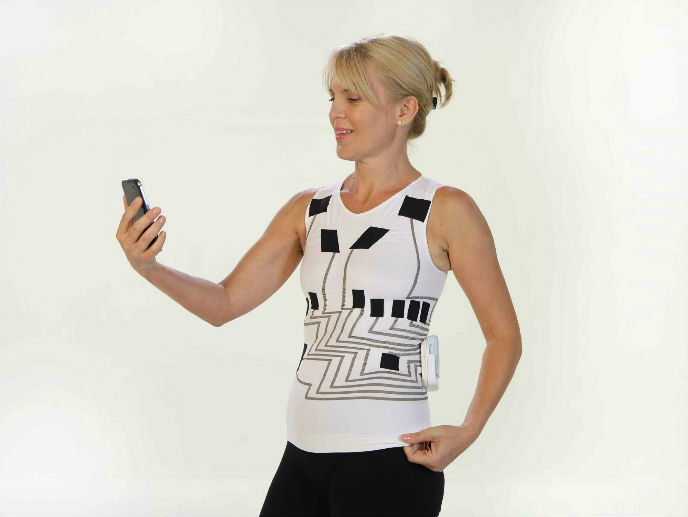A novel electrocardiogram device built into a shirt could cut precious time off confirming a cardiac event needing immediate intervention.
The first product in the hWear line of smart-digital garments by Israel’s HealthWatch Technologies created a buzz at the recent annual meeting of the American Telemedicine Association and is expected to be marketed as an FDA Class II medical device by the end of 2014.
The fully washable hWear shirt is interwoven with a mixture of high-tech nylon threads and conducting fibers placed in the same locations where the 12-15 leads of an ECG machine would be attached to the body, explains Dr. Dov Rubin, vice president for marketing and business development.
ECG signals collected passively by the textile sensors are constantly analyzed for cardiac events such as arrhythmias and ischemia, via medical devices such as a Holter monitor or a Bluetooth unit snapped onto the side of the shirt. An alert to the patient’s and doctor’s smartphone is automatically generated if any of these are detected or if the wearer falls or is immobile for an unusual amount of time.
The game-changing aspect is that cardiac patients won’t have to be hooked up to a machine and covered with adhesives. Most importantly, if a patient blacks out or experiences chest pain, all the medical data showing what happened just before and just after has already been transmitted to the doctor.
“A cardiologist will never diagnose a heart attack without seeing a full 12-lead ECG,” Rubin tells ISRAEL21c. “Time is of the essence. From the moment you detect chest pain till the moment they put you on the table to treat it, every 30-minute delay causes a 7.5 percent increase in mortality. That’s a fresh statistic from the New England Journal of Medicine.”
Cockpit technology
Wearable technology usually refers to strap-on or clip-on fitness monitors such as Fitbit or Apple’s new iWatch, or Itamar Medical’s EndoPat fingertip vascular monitor and WatchPat device for diagnosing sleep apnea. In fact, Rubin was formerly CEO of Itamar. After spending five years successfully commercializing its non-invasive technologies, he moved on to the monitoring device of the future – the smartphone.
“I like to say that we restored the ‘wear’ into wearables, simply because we offer a traditional T-shirt,” says Rubin. “All you have to do is wear it. One or two other companies have come up with T-shirt concepts that monitor heart rate and motion, but they’re used for fitness monitoring, not as a medical device. As far as I know, we are the only ones in the medical arena.”
HealthWatch expects to sell hWear in several countries through distributors. Eventually, you’ll be able to buy the shirt in the corner pharmacy or subscribe to a service that will provide the garment and the monitoring.
The three-year-old bootstrapped company of eight people – half of them textile experts – is based in Kfar Saba and was founded by former Israel Air Force Col. Yoram Romem, who previously cofounded the high-tech parking payment solution Pango and headed several international software companies.
Romem’s experience flying airplanes led to the creation of HealthWatch, says Rubin.
“In the cockpit there’s a master caution button that lights up if a subsystem is failing, to help the pilot focus,” Rubin explains. “He wondered why humans couldn’t have a master caution button to focus attention on a problem in our own systems.”
The product was developed with the input of Prof. David Hasdai, director of the coronary care units at the Rabin Medical Center in Petah Tikva.
https://www.youtube.com/watch?v=kA4F3EMsJc4
Though the conductors in the shirt are invisible, HealthWatch designers decided to depict the ECG leads graphically to make a fun and interest-catching garment that also happens to be anti-bacterial due to the conductive silver and polymers woven inside.
“I see this as the future of where medicine is headed,” says Rubin. “Future models will add oxygen sensing and dehydration sensing, all woven in. The real kicker will be a T-shirt for pregnant women to monitor the baby’s heartbeat via her smartphone. If there is any fetal distress detected, it would send an alert to her obstetrician.”
Large-scale production is expected to be established domestically, “which could help revive the textile industry in Israel,” Rubin adds.
“Looking further into the future of communications, larger broadcasters are interested in adding health applications via a two-way communication pipe to your home for health-monitoring purposes. It’s all about time to treatment. The faster you get treated, the better your chances of survival.”
HealthWatch will be seeking financing to meet inventory and manufacturing costs.
Click here for more information.
















